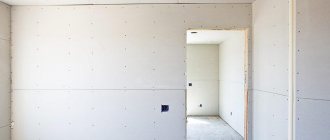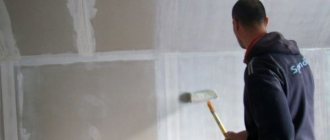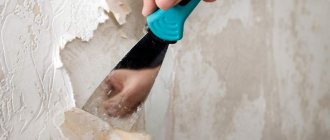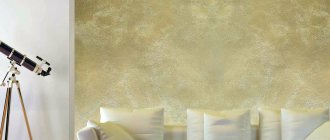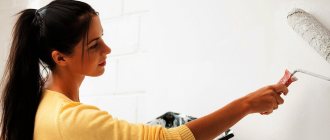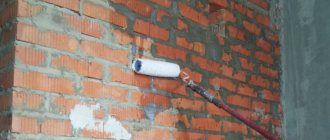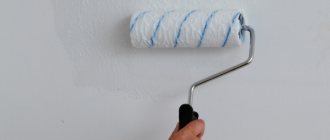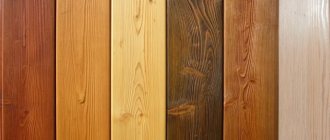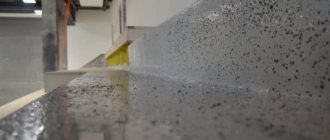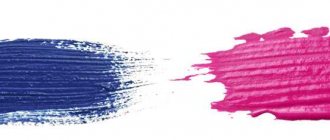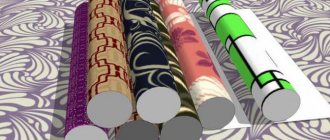Having universal properties, the material plasterboard is widely used in interior decoration and the creation of various interior structures. Puttying is part of the finishing process after installation. Those who are carrying out finishing work using gypsum boards for the first time are interested in whether it is necessary to prime drywall before applying putty. The experience of professionals suggests that you should not skip this stage, as troubles may arise in the future. However, sometimes it is possible to putty without priming the plasterboard surface.
So, when it is possible and necessary to prime the putty, and when it is not, we will tell you below.
What does HA priming do?
The primer is a professional construction mixture that increases the adhesive functions of the materials being joined. Its use ensures ease of application of adhesives, paints and putties. At the same time, the latter are applied without defects and evenly, and their consumption is significantly reduced. In addition, priming is also necessary for drywall itself for:
- fixing seams - the film that forms after the primer dries serves as a barrier against destruction of the gypsum-fiber structure of the material;
- enhancing strength characteristics, since the treated sheets are endowed with additional strength to withstand various types of loads;
- prevention of the appearance of fungi, mold and bacteria (they even produce special primer compositions for this);
- ensuring an economic effect in the future (during subsequent repairs it will be possible to save on materials).
After all of the above, the answer to the question of whether it is necessary to prime drywall before plastering the walls becomes extremely clear. Yes need. However, how to do this?
Conclusion
Many people mistakenly believe that to finish gypsum boards, it is enough to simply apply putty on them - but this is a misconception! In order for the same putty to adhere firmly to the structure and not begin to crumble and fall off over time, it is necessary to prepare a solid base with excellent tenacity.
A beautiful, durable and reliable ceiling will serve you for many years
We hope that we were able to answer the question - does drywall need to be primed before puttying, and that our instructions really helped you in solving the problem that arose.
In the video presented in this article you will find additional information on this topic.
Which primer should I choose?
The choice of primer composition will largely depend on the application technology, the waiting period for drying, the number of repetitions of procedures and other factors.
There is a wide range of primer mixtures on the market today. However, not all of them are suitable for drywall.
List of primer mixtures:
- A universal acrylic composition suitable for treating dissimilar surfaces. The waiting period for the composition to dry varies from 2 to 4 hours.
- The phenolic composition is intended for priming metal or wood surfaces. It is not recommended to apply it over putty. However, it is suitable as an initial layer on HA. Before you buy it, you need to make sure that the composition has permission for use in interior work.
- Alkyd compositions choose wooden surfaces as their area of application even without the presence of a putty layer on them.
- Glyphthalic compounds are among the most effective compounds. But it is permissible to carry out repairs with their participation only in sufficiently ventilated areas. Their presence in the decoration of living rooms is not provided. Recommended for facade work on the outside of the building.
- Perchlorovinyl - they can be used to cover surfaces of different structures, including concrete, brick, putty. But only on the street on the outer wall of the house.
- Polystyrene is combined with plaster and wood. This material is very toxic. It is only allowed to be applied to outdoor surfaces.
- Polyvinyl acetate is combined exclusively with polyvinyl acetate dyes. They have a short drying period - about 40 minutes.
From the entire list of primer compositions for finishing drywall, it is advisable to choose an acrylic composition. It is recommended to treat sheets of HA twice with it - before and after puttying. It is this composition that is largely responsible for providing the plasterboard base with the necessary properties before starting the repair process.
How to apply primer for drywall under putty: basic concepts
Usually a roller with a long handle is used for work. Hard-to-reach places are treated with a regular brush. To make the procedure comfortable, you will need a special tray, the lower part of which has an inclined and ribbed surface. The application technology includes the following transitions:
- Clean the surface from dust.
- Mix the primer solution and pour a certain part of it into a flat container.
- Lower the painting tool into the container, then squeeze out the excess amount of mixture on the ribbed area.
- Apply primer to the joints of the sheets and the places where the screws are screwed in.
- Apply reinforcing tape to the seams and putty the heads of the screws and the joints between the panels.
- After the putty layer on the seams and screws has dried, you need to prime the entire surface of the gypsum board. The solution is applied evenly from top to bottom; drips should not be allowed to form.
What criteria are used to select the composition?
An adequate choice of primer mixture ensures maximum efficiency of its use. Today, construction stores offer a large line of manufacturers offering this finishing product. When choosing a primer, you should carefully read the inscriptions on the labels so as not to make a bad choice.
The first step is to make sure whether the chosen option is suitable for putty or not. Then you need to pay attention to the conditions under which the use of the composition is optimal (indoors or outdoors). Taking into account the fact that plasterboard will be used for manufacturing inside house structures, these conditions should mean “for interior work”. It is best to avoid compounds with a high level of toxicity, as they are harmful to human health.
The brand should be a priority factor when choosing the right product. The cost of the compositions is not high. Therefore, it makes no sense to focus on price. And the savings here are very doubtful. Whereas a much more obvious confirmation of the quality of the product is the fame of the manufacturer.
You can choose a manufacturer based on ease of use of the solution. For example, some companies tint mixtures in yellowish or pinkish shades so that it is easy to monitor the uniformity of the layers.
Having chosen the brand, calculate the required volume. On the packaging of each product there is an indication of the area for which it is designed. In this case, it is necessary to add some reserve of substance for additional processing. The optimal thickness of an individual layer should be about 0.03 mm.
It is important to pay attention to this parameter, since not every manufacturer recommends the optimal layer of composition. When deciding whether to prime the gypsum fiber board and how much primer to stock up on, you should consult with a professional about the correctness of the calculations.
Why prime drywall?
Some craftsmen consider priming walls an optional step in preparing the material for putty. The construction of plasterboard walls itself is a flat plane, so workers often neglect the soil and the puttying process itself. This approach to repair is impractical, because the use of soil provides the following features:
- Treating drywall with primer will give its pores a compacted structure, which allows you to use paint and glue, as well as putty, more economically.
- Depending on the composition of the primer, it may have antifungal properties and also prevent moisture penetration.
- The wall material itself consists of cardboard and gypsum filler; the primer additionally protects and strengthens the surface of the drywall.
- Using a primer, small depressions and scratches that were made during the installation of gypsum board sheets are eliminated.
- Primer of drywall under wallpaper greatly facilitates the process of subsequent gluing of the finish. The same point applies to other materials: tiles, paint and fiberglass.
The use of a primer ensures reliable adhesion of the two surfaces. The mixture perfectly cleans drywall and gives it a smooth structure, which is then treated with putty.
An important step is priming the drywall seams. In the process of cutting chamfers, uneven edges remain on them. When a brush with primer is passed along these edges, they are smoothed and will not interfere with further puttying.
Primer for drywall under wallpaper is a necessary phase of work if putty is not used. In this case, the material will have better adhesion to the wall. The primer will also ensure that old wallpaper comes off easily when it's time to replace it. If this is not done, the wallpaper will come off the drywall along with pieces of material.
What are the stages of the whole process?
After installation is completed, the HA sheets are prepared for finishing work. The very first step is to prime the plasterboard surface. After fixing the slabs to the frame, priming begins.
To apply the primer layer, prepare:
- pre-purchased mixture;
- roller with brush for treating the surface of the structure;
- containers for the primer composition (you can purchase special plastic containers for paint and varnish compositions with corrugations on the walls and a recess);
- protective equipment for personal safety - a respirator will help protect the respiratory organs from damage by harmful fumes, and gloves will protect the skin of your hands. This point should not be neglected, since the soil can cause poisoning of the body.
First of all, apply the primer as described in the manufacturer's instructions. The mixture is prepared based on water. The resulting solution is placed in a separate container.
Using a clean roller, the soil is distributed evenly over the surface. If a composition with color indexing has been chosen, then it becomes easy to control the areas where the solution is applied during work, as well as the completion of its drying period.
Some structural elements (joints, corners, etc.) are not easy to prime with a roller. Therefore, a brush is used in “difficult” areas. Their high-quality sealing is very important; it will affect the strength characteristics of the putty and the resistance to cracking of the finishing of the entire surface.
The second layer is applied after the base layer has dried. The choice of final finish determines the number of applications and the totality of all layers.
For plastering and heavy types of wallpaper, the primer layer is thicker than for standard paper wallpaper or paint.
After the layers have dried, they begin to putty the seams, the sheet itself, and rub down uneven areas.
In addition, priming can complete the rough putty, that is, it can be done again before applying the finishing coat.
Seam processing: preparation
When sealing joints is necessary, the surface of the drywall should be prepared. The master needs to make sure that the connecting points are tightly attached to the frame. Each screw must be screwed into the surface to a depth of 1 mm, without damaging the cardboard. Next, the base is cleaned of dust and dirt, because the quality of the seams and the durability of the structure will depend on this.
Puttying drywall seams involves preparing the sheets themselves, or rather the end parts. Some experts believe that they need to be cut at an angle, which increases the strength of the seam and makes sealing easier. Others recommend eliminating this process, as they believe that the tapering of the edges is done by the manufacturer, and this is enough.
What else do professionals recommend?
Anyone who still doubts whether it is necessary to prime drywall can take into account some of the recommendations of gypsum plasterboard specialists. If the surface of the HA remains clean after trimming, without a hint of dust, then there is no need to prime it. No primer or original seams are required. However, in most cases, horizontal HA joints are given an angle of 45 degrees during installation to ensure better contact with the putty. Such seams must be primed.
In addition, the instructions for finishing work clearly indicate the need to prime the putty before painting.
The primer does not take much time to dry. In addition, these compounds are not expensive. After all that has been said, any sane person will draw the right conclusions and decide for themselves the advisability of using a primer on HA.
Is it necessary to apply primer to walls before puttying?
Renovating your own home is a long and troublesome process. Anyone who decides to carry it out with their own hands will first of all be faced with the problems of choosing the necessary building materials. For example, primer. It seems to be not the most important material, but modern repair work cannot be carried out without this liquid. And the question of whether it is necessary to prime the walls before puttingty or another type of finishing is still relevant today. Many believe that this process is an extra expense, because literally twenty years ago no one knew about this solution.
First, let's figure out why a primer is needed.
- With its help, the adhesive properties of the treated surface are increased.
- The top layer of the wall is strengthened. And it doesn’t matter whether the wall is brick, wood, block, plastered or concrete.
- The film covers grease and oil stains and areas of paint that are difficult to remove. That is, even on such a wall you can apply putty.
- Some species have antiseptic properties. This is especially important in damp rooms.
- In addition, the applied primer reduces the cost of putty.
From the point of view of economy, the last point is interesting. It turns out that less leveling material is used on the primed surface. And since primer is several times cheaper than putty, the savings are obvious. But other items on the list are no less important. Especially when it comes to old walls, fragile with large defects. Here no one will wonder whether it is necessary to prime the walls before puttingty.
